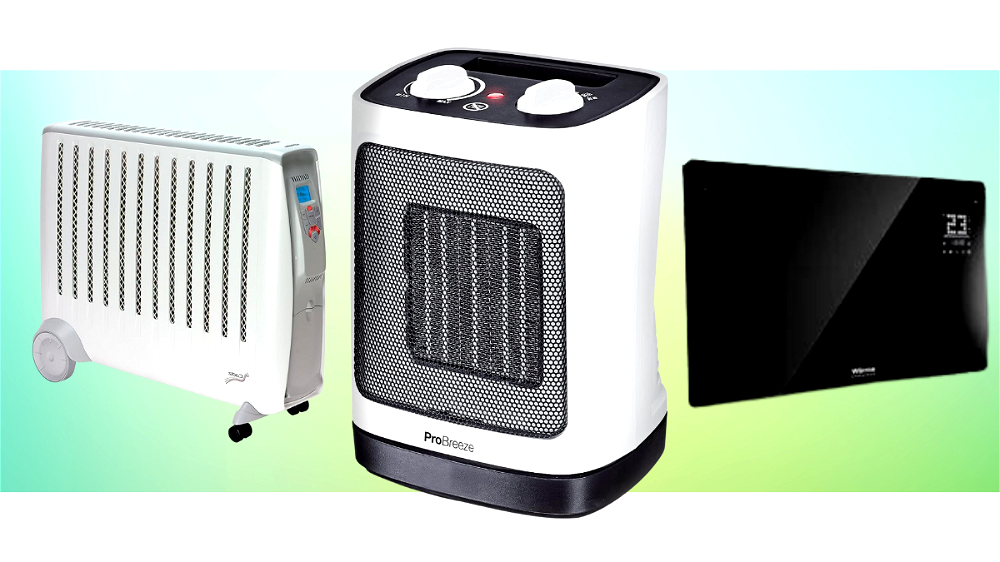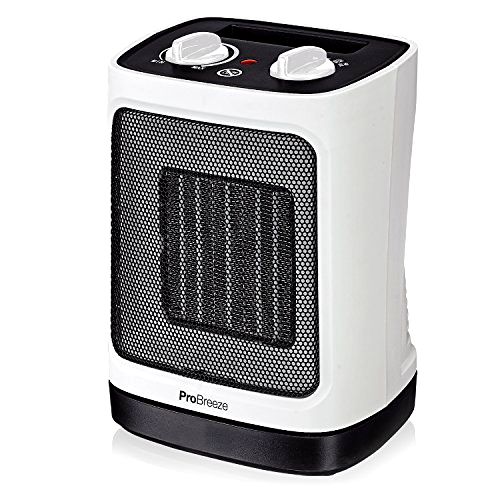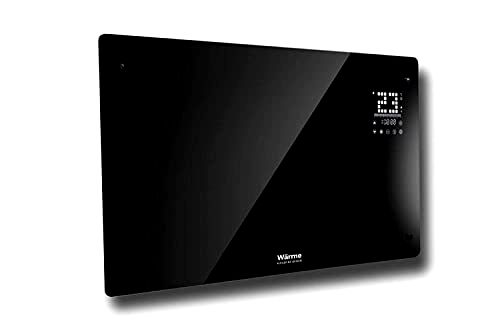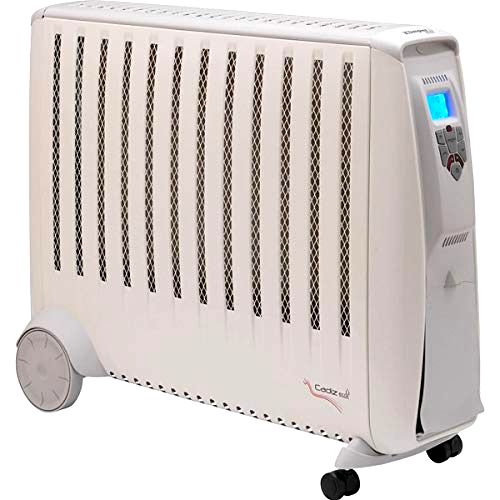Read Reviews
The Best Conservatory Heaters

-
Best ceramic fan heater - Pro Breeze® 2000W Mini Ceramic Conservatory Heater
-
Best wall panel heater - Wärme Designer Electric Conservatory Heater
-
Best adjustable settings - Dimplex Cadiz Eco 3KW Conservatory Radiator
Reviews
1. Pro Breeze® 2000W Mini Ceramic Conservatory Heater[ SAVE 3% ]
Best ceramic fan heater
- A great option for smaller conservatories thanks to its compact size
- Produces heat instantly and quickly heats up small conservatories
- Useful tilt and oscillating mechanisms
- Tip over protection ensures it’ll turn off if the unit is knocked over
- Fairly noisy so may disturb you if you’re working or sleeping, especially on the oscillating setting
- Will struggle to heat large conservatories
- Some users have reported the plug starting to feel hot
- No remote control for changing settings from a distance
- Heat Output
- 2 kW
- Type of Heater
- Ceramic Fan Heater
- Max. Power
- 2000 W
- Heat Settings
- 2
- Built in Thermostat
- Yes
- Weight
- 1.75 kg
- Design
- 4.4
- Heating Power
- 4.2
- Value for Money
- 4.6
Measuring only 18.5 x 15.5 x 26cm, this mini heater is ideal for small rooms. The Pro Breeze 2000W Ceramic Fan will sit perfectly under a desk, but could also be placed on a table top to spread heat at body height.
It’s a handy portable heater that’s really easy to move around thanks to its ergonomic carry handle. You can use it anywhere with an electrical socket nearby.
The Pro Breeze is actually the only convection fan heater on this list, and it effectively blows hot air around the room to keep the conservatory warm. It uses ceramic technology, with ceramic heating elements that make it more efficient than standard fan heaters.
This little heater has two power settings to make it more versatile and reduce energy consumption: 2000 W and 1200 W. You can choose between a powerful heat boost, or a steady flow of warmth. Unlike some fan heaters on the market, the Pro Breeze has no cool air setting, so it can’t double up as a fan on hot days.
There is an easy-to-use adjustable thermostat that helps switch off the heater when the room reaches the desired temperature. Plus, it has overheat protection to avoid it getting too hot, as well as an ‘anti tip over’ switch which will cause the unit to turn off if it gets knocked. The Pro Breeze has the potential to oscillate through 60°, but it can also be used on a static mode.
Compared to some of the more complicated electric heaters on the market, there’s no denying that the Pro Breeze has an easy-to-use, effective and simple design. However, it is therefore lacking some more advanced features. There’s no 24-hour timer, which could help this heater be more energy efficient, and no remote control either.
Did you find this review helpful?
2. Wärme Designer Electric Conservatory Heater
Best wall panel heater
- Adjustable thermostat helps save electricity - turning off when the room reaches desired temperature
- The design is premium, stylish and modern
- Quick heat, doesn't take long to warm up
- Can use a smartphone/tablet as remote control by downloading compatible app
- Option of wall mounting provides safety for kids and pets
- The heater doesn't save your previous settings - you’ll need to reset it each time
- The operational control panel system is very complicated and not particularly user friendly
- Noisy to heat and cool down
- Included manual is complicated - making set up even harder
- Doesn't have a frost prevention setting
- Heat Output
- 2 kW
- Type of Heater
- Panel Heater
- Max. Power
- 2000 W
- Heat Settings
- Adjustable
- Built in Thermostat
- Yes
- Weight
- 9.3 kg
- Design
- 4.8
- Heating Power
- 4.2
- Value for Money
- 4.4
If modern design is your thing, and you’re in the market for a stylish and energy-efficient way to heat your conservatory, the Wärme Flat Screen Wall Mounted Conservatory Heater is a great option to consider.
This electric heater looks extremely stylish, with an ultra-slim design that resembles a flat screen TV at a first glance. It also has smart features and Wi-Fi accessibility which means it can be controlled via an app. This makes it possible to use either a phone or a tablet as a remote control.
Therefore, if you’re after a contemporary wall heater with simple smart features, this is one of the best conservatory heaters to consider.
This heater uses convection technology and has a programmable digital thermostat. It has a standard range of 15 – 35°C.
If you have kids or pets, you might well be concerned about their safety around a conservatory heater. However, this Wärme heater is wall mountable, so it’s kept well out of reach of little hands and wet noses. This feature really sets this heater apart from the others on this list.
It has a 2 kW output, which can comfortably heat a medium room of 22 m². You can set it to instant-heat mode when you need an immediate heat-boost on extra chilly days, or you can program a schedule on a daily cycle. Using these settings will help you to save energy and be more economical.
This heater has overheat protection and a waterproof casing. It’s therefore suitable for placement in the kitchen or bathroom as well as the conservatory.
Overall, the radiator measures 47 x 82cm and is super slim at only 8cm deep. As a result, it weighs a mere 9.3 kg and is therefore easy to move. The wall mounting features means it can be placed anywhere, and it comes with a wall bracket to facilitate this.
With an advanced system like this one, the set up process can be complicated. So, it might not be user-friendly for anyone who struggles with technology. There will also be some clunky noises when the device is cooling or switching on, which is quite normal for heaters.
Did you find this review helpful?
3. Dimplex Cadiz Eco 3KW Conservatory Radiator
Best adjustable settings
- Extremely quiet - just a small click when the thermostat turns on and off
- Capable of heating relatively large rooms very quickly
- Frost protection settings don't use a lot of power but can stop plants from freezing
- If being used near a wall, you can specify which side of the heater the heat comes out of
- Remote control makes it possible to change settings without getting up
- The power cable is at the front of the unit with the LCD display, meaning the display will likely be hidden from view when plugged in
- Not particularly stylish, with a obtrusive and bulky design
- The carry handle is very small and awkwardly shaped
- Quite expensive to run
- Some users have reported this heater discolouring over time
- Heat Output
- 3 kW
- Type of Heater
- Oil Free Radiator
- Max. Power
- 3000 W
- Heat Settings
- 2
- Built in Thermostat
- Yes
- Weight
- 11.1 kg
- Design
- 4.2
- Heating Power
- 4.7
- Value for Money
- 4.4
In terms of adjustability, one of the best conservatory heaters is the Dimplex Cadiz Eco 3KW. It has two panels, one on each side, that you can switch on individually or at the same time.
Individually, the side panels produce 1.5 kW of heat. Together, they produce 3 kW. It’s therefore a very warming heater for winter, but has settings that also make it suitable for autumn and spring.
Another great feature is the electronic climate control system. This enables you to turn the heat up or down in one-degree increments from 5 – 35°C. Also, because this heater goes down to such a low temperature, it can also be used for frost protection without using lots of unnecessary power.
This convection heater produces 3 kW of heat and once you’ve figured out the right temperature for your home, you can set the memory and the heater will remember the settings for next time. Due to its high heat output, this heater is suitable for heating larger rooms.
It’s also programmable in other ways too. There’s a 24-hour timer which can be easily set using the backlit LCD display. This can help save energy, keeping heating bills down, as well as ensure the heater turns off at an appropriate time.
A remote control comes included, so the power settings can be adjusted from across the room, and the heater runs silently which is ideal for reading, watching TV or listening to music.
Dimplex claims that their heater is 10% more efficient than an oil-filled radiator and warms up 30% faster. Their heater is also very cost efficient at most temperatures. It gets less efficient when set over 25°C. However, usually you shouldn’t need to set the heater above 23°C, so this shouldn’t be a problem.
Whilst perhaps not as stylish as some of the other heaters, this is an easy-to-use option from a reputable brand. It’s also quite a portable heater, and can be easily moved around on its castor wheels.
Did you find this review helpful?
Compare Product Features
Use the dropdown to sort the table by the feature you want to see.
Pro Breeze® 2000W Mini Ceramic Conservatory Heater
- 4.4
- 2 kW
- Ceramic Fan Heater
- 2000 W
- 2
- Yes
- 1.75 kg
Wärme Designer Electric Conservatory Heater
- 4.5
- 2 kW
- Panel Heater
- 2000 W
- Adjustable
- Yes
- 9.3 kg
Dimplex Cadiz Eco 3KW Conservatory Radiator
- 4.4
- 3 kW
- Oil Free Radiator
- 3000 W
- 2
- Yes
- 11.1 kg
How to Choose The Best Conservatory Heater
A conservatory is a wonderful place to relax in summer, bridging the gap between your home and garden.
However, in the winter months, your conservatory may get less use. Even with the central heating system running, it can become cold and bleak and feel like a waste of space. What’s more, any plants in your conservatory may die as the temperature plummets (artificial plants might be a solution instead).
Luckily, there’s a range of conservatory-heating solutions that can help you keep it a comfortable space all year round. And, let’s face it, having somewhere to retreat to, that is bright, warm and beautiful, is even more important through the cold, grey days of a British winter.
So, you can keep your conservatory warm and inviting by investing in a conservatory heater.
There are lots of things to look out for, but don’t worry. The following tips will help you make an informed purchase.
Conservatory Heater Benefits
Heaters can help transform the conservatory from a cold zone where no one goes, to another comfortable hang-out spot.
The best conservatory heaters will also help maintain a regular air temperature in the conservatory, which may help keep any heat-loving plants you have in there happy.
Furthermore, these heaters are great to use any time you just feel like you need a little extra boost of heat alongside your central heating. The great thing about this style of heater is that you can buy one predominantly for use in your conservatory, but it will be portable enough for you to take anywhere in the house.
Most of the conservatory radiators on this list can even be temporarily used as a shed heater or garage heater.
Choosing the Right Size
If you’re looking for a heater that you can move around as you wish, make sure that it’s not too large or heavy. Most heaters are designed to be portable, so you’ll probably find it has wheels anyway. But a heavy heater might put you off using it exactly as you’d hoped.
If you only have a small amount of floor space, you should check the dimensions of the heater to make sure that it will fit well. Alternatively, you could consider a wall-mounted electric panel heater that won’t use any floor space at all!
A larger heater won’t necessarily do a more efficient job of heating your space. Generally, a 1kW convector heater will be capable of heating a room of around 14 m³ to a comfortable 22°C.
Energy Efficiency
Most heaters will have an energy efficiency rating displayed in their description. Nowadays, it’s relatively easy to find heaters that are extremely energy efficient, so don’t waste your time considering a model which isn’t up there with the best.
An adjustable thermostat is a great way to make a heater more energy efficient. If you set the thermostat to a certain temperature, the heater will automatically stop heating once it reaches that goal. Naturally, this energy saving feature can also help reduce energy costs.
Similarly, if you buy a heater with a couple of power options, you can avoid using more energy than you need. For example, the Duronic HV102 Heater has two heat modes so you choose between high and low power. Therefore, if you only want low-level heat, you have the option to do so instead of only being able to blast it on full power.
Different Heater Types
There are several different types of heaters which can be used in a conservatory. There are pros and cons to each type, so it will depend on what you’re hoping to achieve.
Convection
These heaters work by warming the air in the room. As the air warms, it rises, and cooler air takes its place. As a result, the warm air is constantly moving around the room. These are a great option if you are looking to warm a whole room. This type of heater often has an intelligent thermostat which can save you money as it avoids overheating. Here are some different types of convector heaters:
- Fan heaters work well and push hot air around the room. They may not be as energy efficient as other heaters because not all energy is put into creating heat; some is used on expelling air. Warm air can be easily lost through open doors and draughty cracks, so it’s important to keep the area airtight if you’re trying to use a fan heater to warm the room.
- Traditional oil filled heaters are slower to heat up than fan heaters but offer steady convection heat. An oil filled model will also stay warm for a while when switched off, so it will continue to heat even when it’s not using any power.
- Electric convector heaters are generally 100% energy efficient, because all of their energy is converted into a heat output. They can be relatively cheap to run and include smart settings to give you more control over your heating.
Radiant
Radiant heaters don’t heat the air like convector heaters do, but they focus on heating the objects directly in front of them. They don’t tend to evenly heat a room. These heaters are perhaps better suited to being used for short periods of time, just to keep one person warm in a static position.
- Halogen heaters, recognisable by their orange glow, will provide warm heat to objects directly in front of them. They are not very efficient at warming a whole room because they do not focus on heating the air.
Most of the heaters on my list are electric convection, as this type is most energy efficient and heats a whole room. This is usually preferred over only heating the surfaces directly in front of the heater.
Safety Considerations
Many heaters will have some safety features. The most common are overheat protection and a safety tip over switch that will the heater off if it’s knocked over. That said, there are still some things to bear in mind when using a conservatory heater.
Don’t leave a conservatory heater on overnight – even if they have a cut-off switch to avoid overheating, it’s still dangerous to leave them unattended for hours.
Be careful about nearby materials – place your heater somewhere with lots of space around it to avoid materials being melted. Also, if you have young children or pets, consider a wall mounted heater that can be installed out of the way.
READ NEXT: The Best Dehumidifiers For Your Conservatory
Conservatory Heater FAQs
This will depend on your usage. In general, the cheapest portable electric heaters are either oil filled, oil-free, or halogen/infrared heaters. Bar fires and fan heaters tend to be more expensive to use in the long run.
Don’t get confused with oil filled radiators vs gas fuelled: these are different. Oil filled heaters do not need to be replenished with oil so there is no recurring cost of re-buying gas cylinders.
Electric heaters are very safe as long as you follow certain precautions. If you have young children around, you might want to choose a wall mounted panel heater and avoid oil filled options. Alternatively, you could use a fan heater or an oil-free panel heater that is positioned out of their reach.
Electric heaters often have a variety of safety features including anti-tip mechanisms which are activated if the unit is knocked over, and cut-out switches to avoid overheating. Always ensure you check the safety guidelines of the heater you choose; each will have different safety requirements.
Using a heater on a low ‘frost protection’ setting can help keep temperatures above freezing in a conservatory. That said, you shouldn’t leave a heater unsupervised overnight.
As well as using a heater, you can wrap your plants in fleecing and take them away from the window ledge, as this is going to be the coldest spot in winter.
You can also use an organic material called mulch, which is placed at the base of your plant. This protects them against freezing and root damage.
Finally, you can DIY a cloche. This can be a glass jar, or a plastic bottle cut in half. Place it over the top of your plant during the night to protect it from getting too cold.
This will depend on where you want to use it. If you’re hoping to bring it from room to room, you’ll benefit from a smaller, lightweight heater. However, if you’re intending to use it in one room, you should feel free to choose whatever sized heater you like.
In terms of heat production, size is not as important as energy output. A small electric heater can still pack a big punch. So, here are some general guidelines for heating your space correctly…
As a general rule of thumb, 1kW will heat 14 cubic metres to a comfortable 22 degrees Celsius.
Bear in mind that non-electric heaters won’t produce a continuous level of heat. They do not keep a consistent energy output, varying from their maximum ability throughout the duration of being switched on. Therefore, for gas fuelled heaters to heat a room of 14 cubic metres, they must have a higher energy output than the figures above, perhaps 2 or even 3kW.




Share